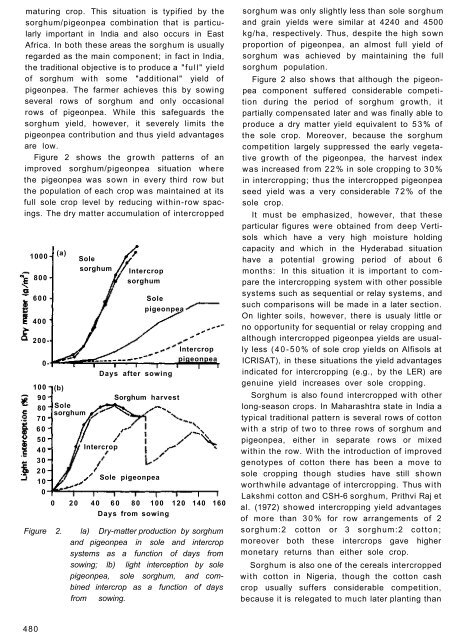RA 00048.pdf - OAR@ICRISAT
RA 00048.pdf - OAR@ICRISAT
RA 00048.pdf - OAR@ICRISAT
You also want an ePaper? Increase the reach of your titles
YUMPU automatically turns print PDFs into web optimized ePapers that Google loves.
maturing crop. This situation is typified by the<br />
sorghum/pigeonpea combination that is particularly<br />
important in India and also occurs in East<br />
Africa. In both these areas the sorghum is usually<br />
regarded as the main component; in fact in India,<br />
the traditional objective is to produce a "full" yield<br />
of sorghum with some "additional" yield of<br />
pigeonpea. The farmer achieves this by sowing<br />
several rows of sorghum and only occasional<br />
rows of pigeonpea. While this safeguards the<br />
sorghum yield, however, it severely limits the<br />
pigeonpea contribution and thus yield advantages<br />
are low.<br />
Figure 2 shows the growth patterns of an<br />
improved sorghum/pigeonpea situation where<br />
the pigeonpea was sown in every third row but<br />
the population of each crop was maintained at its<br />
full sole crop level by reducing within-row spacings.<br />
The dry matter accumulation of intercropped<br />
1000<br />
800<br />
600<br />
400<br />
200-<br />
0-<br />
100<br />
90<br />
80<br />
70<br />
6 0<br />
50<br />
40<br />
30<br />
2 0<br />
10<br />
0<br />
(a)<br />
(b)<br />
Sole<br />
sorghum<br />
Sole<br />
sorghum<br />
Intercrop<br />
Intercrop<br />
sorghum<br />
Sole<br />
Days after sowing<br />
Sorghum harvest<br />
Sole pigeonpea<br />
pigeonpea<br />
0 20 40 6 0 80 100 120 140 160<br />
Days from sowing<br />
Intercrop<br />
pigeonpea<br />
Figure 2. la) Dry-matter production by sorghum<br />
and pigeonpea in sole and intercrop<br />
systems as a function of days from<br />
sowing; lb) light interception by sole<br />
pigeonpea, sole sorghum, and combined<br />
intercrop as a function of days<br />
from sowing.<br />
sorghum was only slightly less than sole sorghum<br />
and grain yields were similar at 4240 and 4500<br />
kg/ha, respectively. Thus, despite the high sown<br />
proportion of pigeonpea, an almost full yield of<br />
sorghum was achieved by maintaining the full<br />
sorghum population.<br />
Figure 2 also shows that although the pigeonpea<br />
component suffered considerable competition<br />
during the period of sorghum growth, it<br />
partially compensated later and was finally able to<br />
produce a dry matter yield equivalent to 53% of<br />
the sole crop. Moreover, because the sorghum<br />
competition largely suppressed the early vegetative<br />
growth of the pigeonpea, the harvest index<br />
was increased from 2 2 % in sole cropping to 3 0 %<br />
in intercropping; thus the intercropped pigeonpea<br />
seed yield was a very considerable 7 2 % of the<br />
sole crop.<br />
It must be emphasized, however, that these<br />
particular figures were obtained from deep Vertisols<br />
which have a very high moisture holding<br />
capacity and which in the Hyderabad situation<br />
have a potential growing period of about 6<br />
months: In this situation it is important to compare<br />
the intercropping system with other possible<br />
systems such as sequential or relay systems, and<br />
such comparisons will be made in a later section.<br />
On lighter soils, however, there is usualy little or<br />
no opportunity for sequential or relay cropping and<br />
although intercropped pigeonpea yields are usually<br />
less ( 4 0 - 5 0 % of sole crop yields on Alfisols at<br />
ICRISAT), in these situations the yield advantages<br />
indicated for intercropping (e.g., by the LER) are<br />
genuine yield increases over sole cropping.<br />
Sorghum is also found intercropped with other<br />
long-season crops. In Maharashtra state in India a<br />
typical traditional pattern is several rows of cotton<br />
with a strip of two to three rows of sorghum and<br />
pigeonpea, either in separate rows or mixed<br />
within the row. With the introduction of improved<br />
genotypes of cotton there has been a move to<br />
sole cropping though studies have still shown<br />
worthwhile advantage of intercropping. Thus with<br />
Lakshmi cotton and CSH-6 sorghum, Prithvi Raj et<br />
al. (1972) showed intercropping yield advantages<br />
of more than 3 0 % for row arrangements of 2<br />
sorghum:2 cotton or 3 sorghum:2 cotton;<br />
moreover both these intercrops gave higher<br />
monetary returns than either sole crop.<br />
Sorghum is also one of the cereals intercropped<br />
with cotton in Nigeria, though the cotton cash<br />
crop usually suffers considerable competition,<br />
because it is relegated to much later planting than<br />
480

















